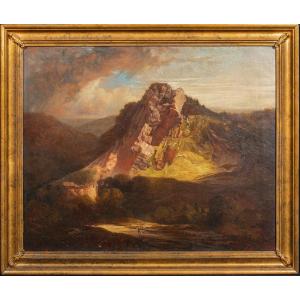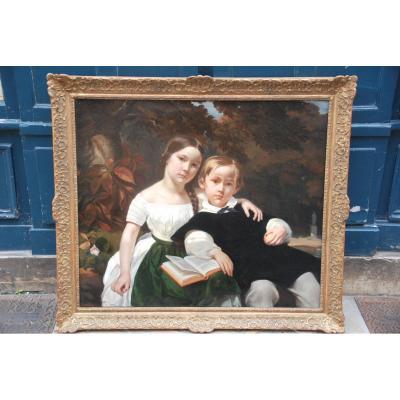by Mariano Fortuny y Marsal (1838-1874)
Large 19th Century Orientalist portrait of a moor looking at his reflection, oil on canvas by Mariano Fortuny Y Marsal. Excellent quality and condition depiction of a Moor gazing at his reflection in a hand mirror. Presented in its original handmade antique pierced gilt frame. Signed.
Provenance
Sale, Christie's London, 1st October 2008, lot 166
Sale, Bonhams Knightsbridge, 19th August 2009, lot 55
by Mariano FORTUNY Y MARSAL (1838-1874) sales to $850,000
Measurements: 26" x 23" framed approx
ARTISTS BIOGRAPHY
Mariano Fortuny y Marsal studied under Claudio Lorenzale at the school of fine arts in Barcelona. In 1857 he was awarded a bursary to study in Rome. He first visited Morocco in 1860, sent by the city of Barcelona as a war artist to commemorate the Spanish victory at Tetouan with a painting. In 1863 he visited Naples, where he met the painter of historical subjects, Domenico Morelli. In 1866 he went to Paris and became friends with French academic painters such as Jean Léon Gérome and Ernest Meissonier. In 1867 he returned to Rome where he became friends with Henri Regnault. By 1869 he was back in Madrid and began to study Goya's technique in earnest. In 1871, in the company of the French orientalist painter Georges Clairin, he visited Tangier and Tetouan. He went to Granada and Seville to study the legacy of the Moors and also visited England. In 1873 he moved to Portici in Italy, but caught malaria there and had to return to Rome, where he died shortly after.
On his visits to Morocco Fortuny made many pencil and watercolour sketches of Arab soldiers and of the country's landscape, habitat, population and animals. When he returned from his travels he used these studies as the basis for paintings and engravings of 'oriental' daily life. He freely copied the weapons, fabrics, wall hangings, carpets, bronzeware and pottery that he brought back from his journeys abroad and kept in his studio; he became famous as a designer of fashionable fabrics and is mentioned by Proust in Swann in Love ( Un amour de Swann).
The luminosity and intense colours of North Africa brought a freshness to his palette and freed him from the classicism of his early style. Goya's influence is also apparent in his work, particularly in La Vicaria. The French poet and critic Théophile Gautier said of this painting that it was like a 'sketch by Goya reworked by Meissonier'. Indeed, Fortuny does share something of Goya's freedom of technique and his palette is closer to that of Goya than Meissonier. What makes Fortuny special is his attention to detail, which he carried to an extreme in the latter half of his career with his fashionable fabric designs. He may sometimes have forgotten that overall composition must take priority over meticulousness of execution but he was an outstanding exponent of the intense and vivid qualities of light. His 'oriental' works include: Arabian Fantasia; On the Hills of Algiers; Fantasia in Granada; Travellers' Halt; Battle of Tetouan in Morocco; and Indian Snake Charmer.
Fortuny's last studies show that he had begun to turn his attention more to the internal structure of landscapes, creating wider, more open skies and concentrating less on superficial detail. Other works include: Penitent Hermit; The Gallant Abbot; Luncheon in the Courtyard of an Old Convent; The Antique Dealer; and Alhambra Courtyard.
Fortuny exhibited at the Barcelona Salon and at various exhibitions organised by the Parisian art dealer Adolphe Goupil, who, from 1870, had exclusive rights to handle Fortuny's work. In 2003 a major retrospective of Fortuny's work was staged by the Museu Nacional d'Art de Catalunya in Barcelona.
Museum and Gallery Holdings
Baltimore (Walters AM): Indian Snake Charmer; Arabian Fantasia; Swiss Guard
Barcelona: Art Lover in his Room; Slave; Moorish Sentry: Moroccan Blacksmith; Moorish Sentry: Battle of Tetouan
Barcelona (MAM del Mus. Nacional d'Art de Catalunya): Battle of Tetouan; Military Officer
Bucharest: Darro Stream
Buenos Aires: Return from the Procession in the Rain
Castres: Bull-running in Spain; Windows
Chicago: Warrior
Cincinnati (Taft MA): Arab Guard
Copenhagen (Ny Carlsberg Glyptotek): Head Study of Young Roman Woman
Dallas (Meadows Mus.): Beach at Portici (Playa en Portici)
London (British Mus.)
London (NG): The Bull-Fighter's Salute (1869?, oil on canvas)
Madrid: Battle of Wad-Ras; Queen Maria Cristina of Spain Reviewing the Troops
Madrid (Prado)
Madrid (Prado, Casón del Buen Retiro): The Artist's Children in the Japanese Salon; Landscape; Moroccan
Mannheim: Head Study of Young Roman Woman
Milan (Mus. Poldi Pezzoli): Tangier (watercolour)
Moscow (State Tretyakov Gal.): Art Lover in his Room; Moroccan Snake Charmers
Munich: Duet
New York (Hispanic Society of America): Tangiers (after 1862?); Arabs Ascending a Hill (1862-1863); Portico, Church of San Ginés (1868)
New York (Metropolitan Mus. of Art): Madame Gaye (1865, oil on canvas)
Paris (Mus. d'Orsay)
St Petersburg (Hermitage)
The Hague (Mus. Mesdag): Anchorite
Venice (Mus. Fortuny): important collection of works
Washington DC (Corcoran Gal. of Art)
Bibliography
Osborne, Harold (ed.): The Oxford Companion to Art, Oxford University Press, Oxford, 1970.
18 acuarelas y dibujos, Mariano Fortuny 1838-1874: Expuestos en Sala Parés, exhibition catalogue, Barcelona, 1972.
Russel, P. E. (ed.): Spain, a Companion to Spanish Studies, Methuen, Suffolk, 1973.
De Osma, Guillermo: Mariano Fortuny: His Life and Work, Aurum, 1980.
Janés, Clara: Fortuny, Sarpe, Barcelona, 1990.
Navascués, Pedro/Quesada Martín, María Jesús: El Siglo XIX: Bajo el signo del Romanticismo, SILEX, Madrid, 1992.
Thornton, Lynne: Les Orientalistes, peintres voyageurs, 1828-1908, ACR Édition, Paris, 1993.
Hamilton, George Heard: Painting and Sculpture in Europe 1880-1940, Yale University Press, Pelican History of Art, Singapore, 1993.
Juler, Caroline: Les Orientalistes de l'école italienne, ACR Édition, Paris, 1994.
Desvaux, Delphine: Fortuny (Fashion Memoir), Thames and Hudson, 1998.
Moffitt, John F.: The Arts in Spain, Thames and Hudson, London, 1999.
Deschodt, Anne-Marie/Poli Doretta, Daranzo: Fortuny, Harry N. Abrams, 2001.
Mariano Fortuny, exhibition catalogue, Museu Nacional d'Art de Catalunya, Barcelona, 2003.


































 Le Magazine de PROANTIC
Le Magazine de PROANTIC TRÉSORS Magazine
TRÉSORS Magazine Rivista Artiquariato
Rivista Artiquariato